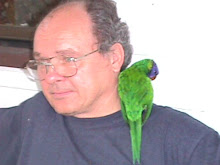This report has been a little
longer than usual in going to press. The
end of September is again one of those busy times for teachers and even though
there was a holiday in the last week of the month there was also the need to
prepare for the last term of school. And
it will be the last term! Retirement
beckons.
There is of course no retirement
among the avifauna of Allen Road. All the
usual species, the resident or at least frequent visitors to Café Avian, remained a constant. The Torresian Crows Corvus orru continue to patrol the Middle Compound and Orchard,
always on the lookout for opportunities to steal our chicken eggs; the male
Australian Magpie Cracticus tibicen
risks life and limb in attempting to surreptiously share Boz’s bones and/or his
dry biscuits; the Grey Butcherbirds Cracticus
torquatus [the older of the two juveniles appears to have left the family
circle] habitually demand their morsels of cheese; the Aposlebirds Struthidea cinerea and Grey-crowned
Babblers Pomatostomus temporalis still
dominate the scene, the former on the verandah and the Drian[n] area, the
latter in and around the Doughnut birdbath. And now we are blessed with a one-legged male
Australian King-Parrot Alisterus
scapularis.
At 58 species September 2013 surpassed
the 50 of September 2012, although it lags behind the 61 of September 2006
[which topped the previous best of 60 in September 2002].
As in all previous recorded
years, the passerines, at 48% of total September sightings, overshadowed all other
species orders. This group, ranging from
a low of 46% [2012] to a high of 61% [2010] has never been topped in the
species order distribution charts for Allen Road; their nearest rivals, the
parrots and allies, managed only an impoverished 14% of sightings.Among the passerines of Allen Road, September is always a good month for the honeyeaters. In eleven of the past twelve years [91.66%] this group has dominated the species family distribution charts. They have topped the September records in all but one of the past duodecuple years, ranging between 10 and 18% of total sightings and even in the year they were not exclusively dominant it was not that they faltered, the pigeons and dove group simply equalled them on 10% of sightings [five species each].
September was good for the local nocturnal
species. The Tawny Frogmouth Podargus strigoides called on two
occasions [the first since January 2013]; the White-throated Nightjar Eurostopdus mystacalis called on four
occasions during the month; the Australian Owlet-nightjar Aegotheles cristatus managed to call only once [25th of
month] while the Southern Boobook Ninox
novaeseelandiae put in frequent vocal performances.
Diurnal raptors were less
numerous but the Pacific Baza Aviceda
subcristata, our first since July 2013, was a welcome addition to the monthly lists as was the Collared Sparrowhawk
Accipiter cirrocephalus which showed
magnificently on very first day of September. Following a minor flurry of activity in and
around Allen Road since May 2013, the Black Kites Milvus migrans put in a solitary appearance in September; their unexpected
heyday is waning in the South Burnett region.
The arrival of the first Sacred
Kingfisher Todiramphus sanctus along
Allen Road heralded the arrival of spring, even if the weather itself vacillated
between winter and mid-summer. The
Australasian Figbird Sphecotheres vielloti played its usual antics, it arrived on the 14th,
called throughout the day and then promptly disappeared before Fay and I could
mount an organized search for the bird. It did more or less the same in 2012, putting
in three brief appearances before going elsewhere. In 2009 it failed altogether.
Other less than common birds included
the Plumed Whistling-Duck Dendrocygna
eytoni which flew overhead on 15 September, their first flyby since
February 2013. The Little Lorikeets Glossopsiita pusilla showed well on the
4th and 28th while the Shining Bronze-Cuckoo Chalcites licidus seems to have taken a
liking to the place, remaining in the immediate vicinity through the month and
even into October. The Leaden Flycatcher
Myiagra rubecula was heard once
during the month, on the 24th while the Spotted Pardalote Pardalotus punctatus called only on the
28th.



